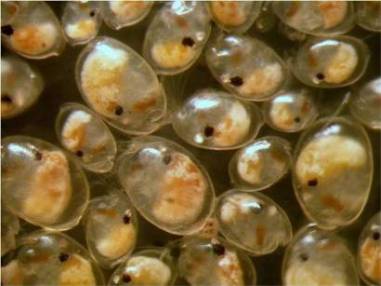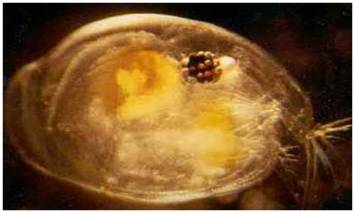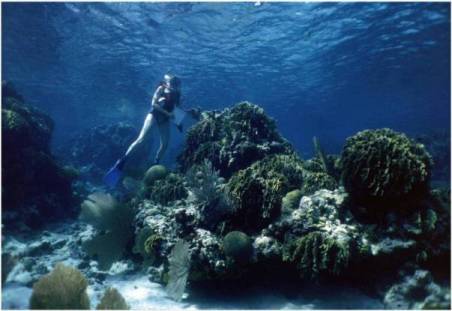Discover the beauty and complexity of Photeros annecohenae, a
marine bioluminescent ostracod!
Photeros annecohenae, formerly Vargula annecohenae, is
a marine bioluminescent ostracod of the phylum Arthropoda that is
found in the Caribbean Sea off the coast of Belize. These ostracods have an outer bivalve carapace composed of chitin that
entirely covers the extremities
 and functions to protect the
organism. They possess many pairs of differing appendages that function in locomotion, sensing the environment,
feeding and mating. This organism also contains a
light organ that creates
chemicals that produce luminescence, a key characteristic of
these ostracods.
and functions to protect the
organism. They possess many pairs of differing appendages that function in locomotion, sensing the environment,
feeding and mating. This organism also contains a
light organ that creates
chemicals that produce luminescence, a key characteristic of
these ostracods.
Luminescence is of great importance to Photeros
annecohenae. Despite the fact that this organism appears
mainly translucent in daylight, come nighttime (late twilight),
males produce elaborate, species-specific
luminescent displays of blue
pulses to attract receptive female mates. These mating displays
are often more obvious indicators of which species is present
than distinguishing a species by
morphology. Groups of males will typically synchronize their
displays in a process called
entrainment, creating captivating light shows of
luminescence. Because their courtship displays are similar to
those of
fireflies, bioluminescent ostracods are often referred
to as “marine firefleas” (Morin 1986). Their luminescence is
also used to deter predators. When attacked Photeros annecohenae
releases a cloud of luminescence that shocks and blinds its
predator. The luminescence is also thought to draw secondary predators
(the predator’s predator). These are two
adaptations
that allow the species to thrive in extremely high abundance
(over 500 individuals per square meter in some locations) (Gerrish 2009).
by
morphology. Groups of males will typically synchronize their
displays in a process called
entrainment, creating captivating light shows of
luminescence. Because their courtship displays are similar to
those of
fireflies, bioluminescent ostracods are often referred
to as “marine firefleas” (Morin 1986). Their luminescence is
also used to deter predators. When attacked Photeros annecohenae
releases a cloud of luminescence that shocks and blinds its
predator. The luminescence is also thought to draw secondary predators
(the predator’s predator). These are two
adaptations
that allow the species to thrive in extremely high abundance
(over 500 individuals per square meter in some locations) (Gerrish 2009).
Photeros annecohenae are extremely small,
reaching a maximum length of about two millimeters. As mentioned
above, their valves contain no pigment, but slight coloration may be seen around the
heart, gut, eyes and light organ.
 This is only a brief summary of
Photeros annecohenae. Many do not know about the complexity of this tiny
organism. I was one of those individuals,
but researching the intriguing organism, especially its use of luminescence during brilliant mating displays and to deter
predators, has helped me appreciate not only the complexity of Photeros annecohenae, but the complexity of all organisms on the
planet and how they interact. Take a tour of the site, and you’ll
see why! Simply click on the links listed to the left or be guided
through the website as you read each page by highlighted words
within the text or links located at the bottom.
This is only a brief summary of
Photeros annecohenae. Many do not know about the complexity of this tiny
organism. I was one of those individuals,
but researching the intriguing organism, especially its use of luminescence during brilliant mating displays and to deter
predators, has helped me appreciate not only the complexity of Photeros annecohenae, but the complexity of all organisms on the
planet and how they interact. Take a tour of the site, and you’ll
see why! Simply click on the links listed to the left or be guided
through the website as you read each page by highlighted words
within the text or links located at the bottom.
The photograph at the top of each page
was taken at Southwater Key, a location close to Carrie Bow Cay
field station where much of the ostracod research used to put
this website together has been obtained and studied by Anne Cohen,
Elizabeth Torres, Gretchen Gerrish, Jim Morin and Trevor Rivers. It
was used with permission from Gretchen Gerrish.
Since the bioluminescent ostracod is not
a part of the group of well-known charismatic megafauna (such as
lions,
tigers and
elephants), you may have never heard of Photeros annecohenae.
If this is true, start off your journey of the organism by
learning how it is classified as
its own species and what organisms it is closely related to!
As mentioned above, I hope your exploration of Photeros
annecohenae leaves you with an even greater appreciation for
the complexity of life. To satisfy this new-found appreciation and
to learn about other interesting organisms, visit websites created
by other UW-La Crosse Organismal Biology students at
www.multipleorganisms.net.
To check out the University of Wisconsin-La Crosse, click the
University of Wisconsin-La Crosse logo below!
